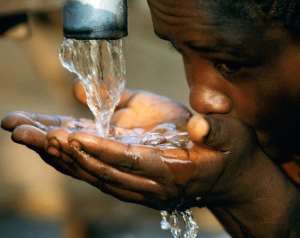
Water, as every average kid globally knows a basic necessity of life, is one of humans most needed resources. The earth as a planet is 70% water. 97% of the water on the earth is salt water. Salt water is not edible, and humans cannot drink this water. 2% of the water on earth is glacier ice at the North and South Poles. This ice is fresh water and could be melted; however, it is too far away from most human residence to be usable. 1% of all the water on earth is fresh water that we can actually use, of that, about 0.505 is in rivers- mostly dammed and treated for drinking water. (American Water Works Association). This statistics demonstrate to us the challenge we face in securing water access for our consumption.
Water as a spatial resource is very abundant but its availability for human consumption and access can shrink. This shrinkage can really be identified and witness in most developing and underdeveloped countries in Africa, Latin America, and even developed countries like China. Due to this shrinkage and limitations which is actually caused by human activities, water scarcity was listed the 5th Global Challenge in 2010 and now the 2nd Millennium Global Challenge- second to Climate Change. Water scarcity represents a major political, economic and human rights issue driving vulnerability and conflict in many countries.
In Ghana, 7 million people in rural areas lack water as 2.5 million of urban population lack water. 80% of all diseases in Ghana are caused by unsafe water and poor sanitation as more than three million people don't have access to safe drinking water. (www.water.org/country/ghana). Non-Governmental Organizations, Government agencies and Cooperate Individuals are therefore encouraged to undertake projects that helps improve water quality and extend water access to rural and other urban areas.
However, most of the threat could be campaigned on and minimized- if not stopped at all. Clean fresh water is vital to our lives and many of the plants and animals we depend on. Most people think water pollution comes directly from a factory or other known source, a type of pollution known as “point source pollution.” However, because of laws and efforts by the Environmental Protection Agency (E.P.A), most of those sources of pollution have cleaned up their act. Today, the biggest source of pollution is us – you and me. This type of pollution is known as “nonpoint source pollution” because it can't be traced to one single source; we can't tell how much pollution is coming from where.
Improper disposal of waste into rivers, defecating in rivers, small scale mining, and other activities has destroyed most of our rivers in Ghana. Their flow, ecological health, quality, rate of discharge and recharge has all been affected and therefore, they cannot serve their domestic, agricultural and industrial purposes anymore.
In 2005, the United Nations launched the Water for Life Decade to help create a greater awareness of the need to better care for our water resources.
Today, known as the World Rivers Day, is annually celebrated on the last Sunday of every September. World Rivers Day is a celebration that highlights the many values of rivers and strives to increase public awareness and encourages the improved stewardship of rivers around the world. Rivers in virtually every country face an array of threats, and only through our active involvement can we ensure their health in the years ahead. Surprisingly, despite the global threat of water scarcity and lack of access to clean water, not all countries are World Rivers Day activists.
The world faces water scarcity threat, so as it's continents. More than one-third of Africa's population lacks access to safe drinking water, More than 400 million Africans now live in water-scare countries and unless we change out attitude, two-thirds of the world's population will face water scarcity.
I charge every youth; the safety of our future and the future of our children, grandchildren and unborn generations lies in our hands. Let us adopt conservational attitudes and volunteering spirits, let us take natural resource management as an individual responsibility before we suffer “tragedy of the common”. Its my world, your world, and our world; let us keep it safe.
Amponsem Joshua
- follow Joshua on twitter @AmponsemJoshua




 Former Kotoko Player George Asare elected SRC President at PUG Law Faculty
Former Kotoko Player George Asare elected SRC President at PUG Law Faculty
 2024 elections: Consider ‘dumsor’ when casting your votes; NPP deserves less — P...
2024 elections: Consider ‘dumsor’ when casting your votes; NPP deserves less — P...
 You have no grounds to call Mahama incompetent; you’ve failed — Prof. Marfo blas...
You have no grounds to call Mahama incompetent; you’ve failed — Prof. Marfo blas...
 2024 elections: NPP creates better policies for people like us; we’ll vote for B...
2024 elections: NPP creates better policies for people like us; we’ll vote for B...
 Don’t exchange your life for wealth; a sparkle of fire can be your end — Gender ...
Don’t exchange your life for wealth; a sparkle of fire can be your end — Gender ...
 Ghana’s newly installed Poland train reportedly involved in accident while on a ...
Ghana’s newly installed Poland train reportedly involved in accident while on a ...
 Chieftaincy disputes: Government imposes 4pm to 7am curfew on Sampa township
Chieftaincy disputes: Government imposes 4pm to 7am curfew on Sampa township
 Franklin Cudjoe fumes at unaccountable wasteful executive living large at the ex...
Franklin Cudjoe fumes at unaccountable wasteful executive living large at the ex...
 I'll 'stoop too low' for votes; I'm never moved by your propaganda — Oquaye Jnr ...
I'll 'stoop too low' for votes; I'm never moved by your propaganda — Oquaye Jnr ...
 Kumasi Thermal Plant commissioning: I pray God opens the eyes of leaders who don...
Kumasi Thermal Plant commissioning: I pray God opens the eyes of leaders who don...
